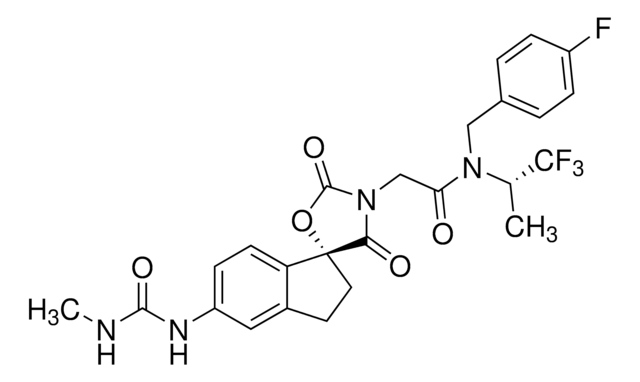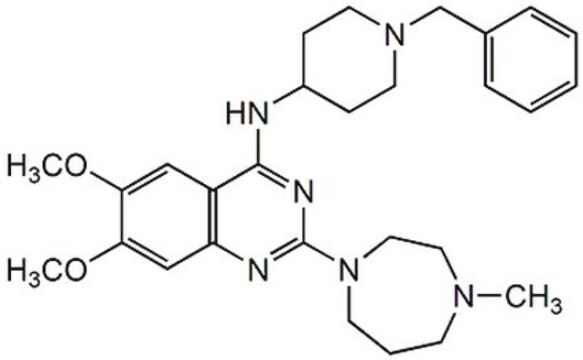382113
C646
≥99% (sum of isomers, HPLC), solid, histone acetyltransferase p300 inhibitor, Calbiochem®
Synonyme(s) :
Histone Acetyltransferase p300 Inhibitor, C646, 4-(4-{[5-(4,5-dimethyl-2-nitrophenyl)furan-2-yl]methylidene}-3-methyl-5-oxo-4,5-dihydro-1H-pyrazol-1-yl)benzoic acid, p300/CBP Inhibitor IV, Histone Acetyltransferase Inhibitor V, HAT Inhibitor V
About This Item
Produits recommandés
Nom du produit
Histone Acetyltransferase p300 Inhibitor, C646, Histone Acetyltransferase p300 Inhibitor, C646, CAS 328968-36-1, is a cell-permeable, reversible inhibitor of p300/CBP HAT (Ki = 400 nM). Competes with acetyl-CoA for the p300 Lys-CoA binding pocket.
Niveau de qualité
Essai
≥99% (sum of isomers, HPLC)
Forme
solid
Fabricant/nom de marque
Calbiochem®
Conditions de stockage
OK to freeze
protect from light
Couleur
brick red
Solubilité
DMSO: 50 mg/mL
Conditions d'expédition
ambient
Température de stockage
−20°C
InChI
1S/C24H19N3O6/c1-13-10-20(21(27(31)32)11-14(13)2)22-9-8-18(33-22)12-19-15(3)25-26(23(19)28)17-6-4-16(5-7-17)24(29)30/h4-12H,1-3H3,(H,29,30)/b19-12-
Clé InChI
HEKJYZZSCQBJGB-UNOMPAQXSA-N
Description générale
Conditionnement
Avertissement
Reconstitution
Autres remarques
Informations légales
Code de la classe de stockage
11 - Combustible Solids
Classe de danger pour l'eau (WGK)
WGK 3
Point d'éclair (°F)
Not applicable
Point d'éclair (°C)
Not applicable
Certificats d'analyse (COA)
Recherchez un Certificats d'analyse (COA) en saisissant le numéro de lot du produit. Les numéros de lot figurent sur l'étiquette du produit après les mots "Lot" ou "Batch".
Déjà en possession de ce produit ?
Retrouvez la documentation relative aux produits que vous avez récemment achetés dans la Bibliothèque de documents.
Notre équipe de scientifiques dispose d'une expérience dans tous les secteurs de la recherche, notamment en sciences de la vie, science des matériaux, synthèse chimique, chromatographie, analyse et dans de nombreux autres domaines..
Contacter notre Service technique








